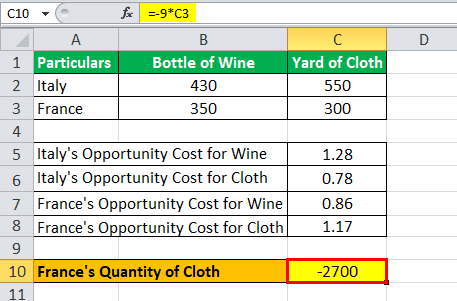Table Of Contents
What is Comparative Advantage Formula?
The comparative advantage formula is an economic factor that calculates the comparative advantage between two countries producing the same goods in their own countries. On an absolute basis, a country can produce more of a particular good than the quantity produced for the same good in another. But that does not imply that the country that produces more goods on an absolute basis has an advantage over other countries. Therefore, it is important to understand the opportunity cost for producing other wells to find an advantage comparatively.
David Ricardo developed the equation for calculating comparative advantage in 1817. It is calculated by finding the opportunity cost for a set of goods. Suppose two neighboring countries produce two sets of similar goods. So to find out the comparative advantage for those two goods, we need to find out the opportunity cost for producing one good over the other good as the number of skilled labor is the same. Comparative advantage is calculated as
Comparative Advantage = Quantity of Good A for Country X / Quantity of Good B for Country X

This formula will help us calculate the opportunity cost for product A; similarly, we need to calculate the opportunity cost for product B. We will do that for both countries. We will be able to determine the comparative advantage of a particular good for a country compared to others by looking at the product of the formula.
Key Takeaways
- The comparative advantage technique measures the relative efficiency of two countries producing identical goods in their respective economies.
- Absolute advantage refers to a country's ability to produce more of a specific good than other countries, but it does not necessarily indicate an advantage over other nations.
- Understanding the opportunity cost of producing other goods is essential to analyze comparative advantage.
- When countries specialize and produce based on their comparative advantages, it can lead to higher total economic output for both nations.
- This specialization also fosters the potential for increased global trade between the two countries.
Examples of Comparative Advantage Formula
Let’s see some simple to advanced examples of Comparative Advantage Equation to understand it better.
Example # 1
Let us try to understand the concept of comparative advantage with the help of an example. Suppose the two neighboring countries, Italy and France, produce wine and manufacture clothes. Let us try and find out which country has a comparative advantage over the other for these two goods. The quantity of each good for each country is presented below. For Italy, the opportunity cost for producing wine is 1.28 yards of cloth, and the opportunity cost for manufacturing a yard of cloth will be .82 bottles of wine. For France, the opportunity cost for producing wine is .86 yards of cloth, and the opportunity cost for manufacturing a yard of cloth will be 1.17 bottles of wine. On an absolute basis, Italy produces a higher quantity of both goods. But on a comparative basis, the opportunity cost for producing a cloth concerning wine is lesser, so Italy should produce more cloth. Similarly, on a comparative basis for France, the opportunity cost for producing wine concerning cloth is lesser, so Italy should produce more wine.
Below is given data for the Calculation of the Comparative Advantage formula.

Suppose Italy ends up producing only cloth as Italy has the comparative advantage of producing cloth over France, and France ends up producing only wine as France has the comparative advantage of producing cloth over Italy. Let us see how that will increase the total economic output for both countries.
Suppose Italy has seven working days and France has nine worker days.
Calculation of Italy’s Quantity of Wine

The quantity of wine produced will be -7*430
=-3010
Calculation of Italy's Quantity of Cloth

The number of yards of cloth manufactured will be 7*550
=3850
Calculation of France’s Quantity of Wine

The quantity of wine produced will be 9*350
=3150
Calculation of France’s Quantity of Cloth

The number of yards of cloth manufactured will be -9*300
=-2700
So the net result for the output for these goods for these two countries will be higher production of wine by (-3010+3150) = 140 bottles of wine and (3850-2700) = 1150 yards of cloth.
Example # 2
Oil-producing countries like countries that are part of OPEC have a comparative advantage for producing a lot of chemicals. Many chemicals are by-products of crude oil for which they have huge reserves. So a country that is producing crude has a comparative advantage over a country that is not producing crude in terms of manufacturing chemicals.
Example # 3
A country like India has a huge comparative advantage compared to the western country in terms of the outsourcing industries. Since India has a huge population of young educated English-speaking people, this acts as an advantage to provide scale and price competitiveness, resulting in a lot of work being outsourced in India.
Relevance and Use of Comparative Advantage Formula
It is important to figure out the comparative advantage for goods among countries. Countries produce goods in the region or country with a higher comparative advantage due to labor, population, or the overall ecosystem. As we have seen in the example above, if counties produce based on their comparative advantages, then the total output in the economy for both countries can be higher. In a way, it enhances the chance of much improved global trade between the two countries. In today’s age of It is important to figure out the comparative advantage for goods among countries. As we have seen in the example above that if counties produce on the basis of their comparative advantages then the total output in the economy for both countries can be higher. This in a way enhances the chance of the much improved global trade between the two countries. In today’s age of globalization, comparative advantage plays a major role.

